#but prior to those Sharon was the most sympathetic character in the book
Explore tagged Tumblr posts
Text

Captain America (2005) #36
#also I haven’t been posting about her because I needed time to formulate my thoughts#but I went into this book not having any idea what was gonna happen with Sharon#and I got so invested in her storyline#some of the flashbacks to when Bucky was younger at the end got to me#but prior to those Sharon was the most sympathetic character in the book#it’s not brought up afterwards but Sharon was definitely under Dr. Faustus’ control when she got pregnant#and he was influencing her to make her fall deeply in love with Steve#but she wasn’t confused about having sex with him#she was just disturbed that she told him she loved him and didn’t betray him to SHIELD#because those she recognized as out of character for her#I think it makes sense that Sharon’s feelings once she’s free from that mind control are dominanted by that she killed Steve#but I’m hoping that future comics with Sharon delve deeper into this very messy situation#she was so focused on her job at the beginning of the book I don’t even know if she had wanted to have kids#also I was very confident that something was gonna happen to make Sharon lose her baby up until I got to that part in the book#and then I was like nooo she’s definitely gonna win this fight#but that did not happen#and then I was like nooo they could still reveal that the baby survived in next issue even though Sharon got stabbed in the stomach#but that did not happen either#marvel#sharon carter#my posts#comic panels
2 notes
·
View notes
Text
“Female friendship assumed a crucial role in novels that revolved around companionate marriage and assumed that parents could no longer legitimately choose husbands for their daughters and that friendship should partially or wholly define the ideal relationship between husband and wife. Historically, such philosophers as Aristotle and Montaigne had associated friendship with equality, similarity, and a reciprocal affection based on reason, in contrast to marriage, perceived as a naturally hierarchical relation based on irrational passions that defied control. Beginning in the late seventeenth century, an increasing tendency to view marriage in egalitarian terms transformed it into something like friendship between husband and wife, making friends agents of marriages rather than mere relief from the trammels of wedlock.
The liberal democratic principles subtending the companionate marriage plot defined young women as individuals capable of maturation and development, though often within more restricted limits than those placed on men. The heroine of a companionate marriage plot must know herself in order to choose a husband wisely; once freed from the requirement either to obey or reject parental dictates, she is aided in her quest for self-knowledge by friends who are equals and peers. Dorothea ignores the parental figures who attempt to dictate whom she should marry, but her encounter with Rosamond prompts the self knowledge that leads her to marry Will. Friendship between women becomes a model for managing social bonds in a capitalist democracy that promotes equality and individualism, cohesion and competition.
In a novel about community and its fissures, the relationship between Rosamond and Dorothea provides one of the more hopeful glimpses of two very different people speaking openly about what separates and unites them. Their moment of amity converts the jealousy, rivalry, and secrecy that initially divide them into a sense of connection, and as such also provides a model for how men and women, as well as the rival camps of Middlemarch, can resolve their differences. Friendship between men is too vast a subject to be given its due here, but a brief discussion of its place in Victorian literature and society can help us to understand what was specific about female friendships. The first point to make, because it is the more surprising one, is that Victorians celebrated friendships between men, especially young men, in terms very similar to those used to laud intimacy between women.
Lifewriting, conduct books, photographs, and educational treatises praised sentimental, spiritual, romantic, and physical bonds between men and made no fixed connections between male friendships and the legal category of sodomy or the controversial but common practice of sex between older and younger boys at public schools. Friendship between men was believed to promote enlightenment ideals of self-cultivation, sympathetic communion, and civic association. For men as well as for women, such friendships were shot through with erotic yearnings and domestic intimacies that were openly avowed; men did not hide that they slept in the same bed or made plans to live together.
For both sexes, friendship was an opportunity to engage in cross-gender behavior with impunity, within the confines of a same-sex relationship. As we saw in the previous chapter, women and girls could act toward female friends in ways they could not toward men; conversely, boys and men could more easily display susceptibility and sentiment with each other than with women, as Thomas Hughes’s Tom Brown’s Schooldays (1857) demonstrates. Friendship for both sexes thus reinforced gender identity and provided respite from gender constraints. Male friendships also differed from those between women. Friendship between boys was much more likely to be described as a phase that ended when one of the men married, and it was more often understood in terms of rivalry, hierarchy, and sexual difference.
Female friendship enforced an altruistic economy of reciprocity and a model of subjectivity based on cooperation, and its repertoire of bodily gestures emphasized contact between undifferentiated body parts such as hands, eyes, and lips. Male friendship feminized both of the boys involved, but was often described as feminizing one more than the other, resulting in a couple modeled more on the exaggerated gender differences of hierarchical marriage. Even when female friends adopted behavior associated with men, their relationship was still seen as intensifying the femininity of both parties. As a result, female friendship was more often compared to companionate marriage, which asked both husband and wife to develop traits associated with feminine forms of sociability. At its most minimal, female friendship takes the form of neutralized enmity.
Thomas Hardy’s Far from the Madding Crowd (1874) represents even that scant degree of friendship as powerful enough to reconcile female rivals and anticipate friendship between husband and wife. Like Middlemarch, Hardy’s novel is a remarriage plot, in which the heroine learns how to love a husband as a friend only after surviving a disastrous first marriage. For Bathsheba Everdene, learning to overcome jealousy of her husband’s erstwhile lover, Fanny Robin, is a crucial step on the road to a companionate union. Bathsheba learns of Fanny’s existence only after her death, when Troy flaunts his preference by ordering Fanny an expensive tombstone and planting her grave with flowers.
Though it would be consistent with her character for Bathsheba to despise the woman whose demise has only intensified Troy’s love, she behaves with uncharacteristic gentleness towards Fanny’s body and memory by tending her corpse and then replanting her grave after a storm destroys the flowers Troy had planted. Bathsheba’s initial perception of Fanny as a “rival” (229) gives way to a sympathy for the dead woman that constitutes a sort of posthumous friendship. In the plot of female amity, love between friends develops the emotional disposition necessary for companionate marriage.
Bathsheba’s retroactive friendliness toward Fanny germinates the compassion that flowers in her marriage to the aptly named Gabriel Oak, which the narrator assesses as a happy union because it realizes the “good-fellowship—camaraderie— . . . seldom superadded to love between the sexes” (303). The narrator connects female friendship to companionate marriage through the water imagery that dominates both Bathsheba’s care of Fanny’s grave and the narrator’s last words about her marriage to Gabriel. Troy plants flowers on Fanny’s tomb but fails to notice that its position directly beneath a rainspout means that the first rain will destroy his blooms, much as his heedlessness helped cut Fanny down in her prime.
It is Bathsheba, aided by Gabriel, who repairs the damage done by the “gurgoyle” that channels rainfall into an attacking force echoing her own prior hostility to Fanny: “The persistent torrent from the gurgoyle’s jaws directed all its vengeance into the grave” (242). By replanting the uprooted flowers, wiping the mud from Fanny’s gravestone, and diverting the gurgoyle’s spout, Bathsheba expresses a newfound “superfluous magnanimity” that replaces her initial impulse to reduce an already dead rival to dust (246).
That generosity redounds to Bathsheba’s credit at the novel’s end when she attains with Gabriel a love as “strong as death—that love which many waters cannot quench, nor the floods drown, beside which the passion usually called by the name is evanescent as steam” (303–4). The amicable deed of protecting Fanny’s grave from a destructive torrent metaphorically returns in the form of a marital friendship similarly resistant to water’s volatility and violence. Far from the Madding Crowd miniaturizes the plot of female amity: an elegiac gesture of friendship toward another woman begins to teach Bathsheba how to transmute stormy passion into the companionable affection that characterizes her happy marriage to Gabriel Oak.”
- Sharon Marcus, “Just Reading: Female Friendship and the Marriage Plot.” in Between Women: Friendship, Desire, and Marriage in Victorian England
9 notes
·
View notes
Photo

Rhea Seehorn: Who is Kim Wexler?
“I saw that something was eroding in Kim for multiple seasons.”
Awards Focus: In the season four finale, Kim was stunned when Jimmy revealed his emotional speech to get his law license reinstated was just a performance. She’s left standing in the hall as he races off to change his name to Saul Goodman.
This year, it’s Kim’s turn to leave Jimmy on his heels. Were you shocked when she left her work on Mesa Verde and subsequently started brainstorming about decimating Howard’s career to get Jimmy his Sandpiper case money?
Rhea Seehorn: Well, to be fair, it is a series of decisions. I saw that something was eroding in Kim for multiple seasons. And what I appreciate about our series, like Vince (Gilligan) and Peter (Gould) did with Breaking Bad, it’s about incremental decisions that these people are making. They’re unaware that they’re falling off a complete cliff. I didn’t know what that final scene was going to be. But I took every step that was handed to me with the information she had presently and played that scene.
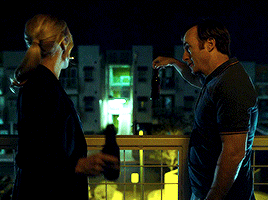
AF: You’ve said you’ve seen erosion going on in Kim, can you speak more to that?
Seehorn: The beauty of the show is that these characters are so affected by their past, not only by the events we’ve seen on the series but even before that. From the beginning of the series there was something about Kim’s stillness and her need for control and to right every ship. When I looked at that, I asked “What are you trying to get away from?” or “What are you suppressing that’s so chaotic that you need to make sure that everything is steady all the time?” Those questions spoke to me about the changes we’re seeing in the latter half of this season.
AF: So there’s a potential “Slippin’ Kimmy” underneath the Kim we’ve come to know?
Seehorn: About halfway through the season, Peter (Gould) said that he and the writers started thinking about the masks we all wear and what’s behind Kim’s mask. I will be very interested to see if she follows through with the decimation of Howard Hamlin and can she stomach those actions? Is she a person now who doesn’t even have a conscience? When she shoots the finger guns at Jimmy, there’s a menacing undertone that certainly concerns him.
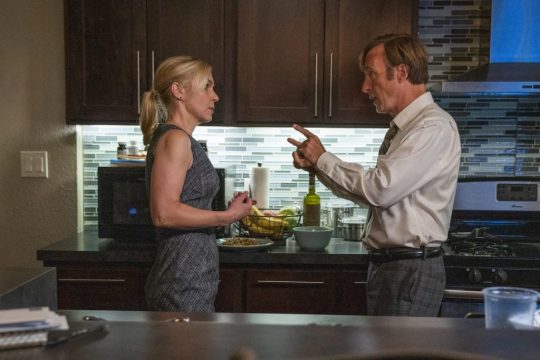
AF: There’s so many telling moments about Kim’s character. The moment when she and Jimmy are throwing the beer bottles off the roof, but Kim cleans up the glass the next morning. If Kim does goes through with this plan for Howard, do you think she would follow suit in some sort of attempt to clean up that mess as well?
Seehorn: That’s a good question. If Kim goes through with her plan, there may no way for Howard to recover. Michael Morris directed those beer bottle scenes, I love how they tie the episodes together. The first one where Kim had some animosity about her saying the name Saul Goodman and then when they’re tossing the bottles together it’s a bonding moment.
AF: Bob (Odenkirk) has spoken about living with Patrick (Fabian) and yourself in Albuquerque. Can you give our audience a look into the behind the scenes life during production?
Seehorn: The three of us have been living together for the last two years and prior to that Bob and Patrick lived together for a season without me. Frankly, I wish we’d been doing it the whole time. It’s so helpful because the scripts are so dense and complex and you’re always wishing you had more time to play with them and find new things.
AF: As you’ve pointed out, the scripts are often dense. When you have a dialogue heavy episode, how much of that preparation is just getting a grasp on the material?
Seehorn: A lot of it. Jonathan Banks and I laugh because we have the same philosophy. If you think you’re off book, then you need to ask yourself, “Are you off book riding a bike? Are you off book standing on your head? Are you off book swimming in the ocean?”
You think you know your lines and then as soon as you’re asked to do something, or you try blocking, or your scene partner decides to do whatever they’re going to do, the words start to slip away from you. There’s just no time for that with our shooting schedule, not if you want to bring your A-game.
AF: Is there a general time set aside for working through the scripts at the house?
Seehorn: If you’re having a cup of coffee in the main kitchen, you’re gonna get asked to read lines. You basically need to hide in your room if you don’t want to run lines, because if you are seen or visible anywhere in the house, you’re going to get asked. And we run lines that are not our scenes too. Like if Howard has a scene with someone else, then I’ll be whoever he’s talking to and it’s great.

AF: The scenes between Lalo (Tony Dalton) and Kim are incredible this season. Before we dive into specifics, talk about working with Tony and his presence as Lalo.
Seehorn: I mean, how great is Tony? What a find that Sherry Thomas and Sharon Bialy brought to Vince and Peter. He’s so talented, but he’s also a very generous actor. It doesn’t matter if he’s not talking for the majority of the episode nine confrontation, he’s giving me so much in that scene once I’m toe-to-toe with him.
AF: We saw a different Kim when she meets Lalo in jail. Can you talk about crafting that confrontation?
Seehorn: I spoke with Gordon Smith, who wrote episode eight, about the idea of when is Kim off her game? Because previously, we’d seen that she can fall apart in a stairwell or at home, but once she walks into a courtroom or a meeting, she suppresses all of that, and can be totally professional.
So, I went in there questioning “Do we think she can actually hold herself together right now?” We decided that she probably hasn’t slept at all and she knows this is a very scary situation. She’s pretty sure that Jimmy is dead or dying in the desert right now and she can’t call the police and tell them what happened. So, she’s trying to get information from Lalo and she’s unsuccessful in that scene whereas in episode nine she is successful.
I like that Kim got two attempts to go at Lalo using intelligence and rhetoric. The second one in episode nine, written and directed by Tom Schnauz, was a monster of a scene and we knew it.
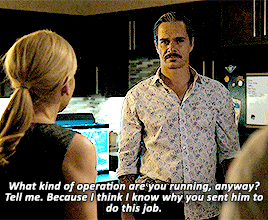
AF: What were some of the logistical considerations for the episode nine faceoff?
Seehorn: Tom came to Bob and Tony and I, and asked if we could rehearse it on set. It’s technically a difficult scene, I have the big monologue at the end, but Tony has to play a lot of different things as he’s reacting to what he’s hearing from Bob and then Kim.
For Bob, he has to repeat the same story but slightly differently, I think four times, which for an actor is very hard material to memorize because you lose track of where you are in the loop. Tom had written in purposeful nuances as Jimmy sort of devolves in his storytelling.
So we rehearsed it, and thankfully we made a lot of decisions with Marshall Adams (the director of photography) and our camera ops and lighting people. That allowed us to get ahead of the curve and give ourselves the hours that we had to shoot it instead of losing time on the technical aspects.
AF: At the beginning of that scene, you have to be very present for Bob and Tony, conveying that sense of dread and uncertainty that Kim feels. What’s going through her head there?
Seehorn: Kim is in survival mode for the first half of the scene. She’s very still, but she’s practical. I think she’s immediately thinking, “Could we jump from this balcony? Where are the knives in the house? Could Jimmy and I take him if we had to?” Eventually, she’s run out of options and is left with observing Jimmy and what unfolds in front of her.
AF: Kim knows that Jimmy is lying to Lalo and that Lalo either suspects it or knows it.
Seehorn: She knows there’s a secret involving the bullet hole in the mug, and that the secret is so great that Jimmy is literally crumbling in front of her and it needs to be protected at all cost for some reason.
AF: And then Kim steps up to the plate, which was the most harrowing moment of the season. Were you always meant to get so close to Tony, having Kim invade Lalo’s space like that?
Seehorn: Yeah, that was in the script. I spoke to Jennifer Bryan, who’s brilliant with our costumes, and I said, “Kim’s coming from work so she has her heels on… do you think we can get the shoes off in the scene?” I talked to Tom Schnauz about having Kim’s shoes off because I wanted to be even physically smaller than Lalo.
Kim switches to pragmatism in that moment, that’s her fight or flight. She wants to go toe-to-toe like she’s proving a case, finding the holes in Lalo’s story and sewing enough doubt that he backs down.
AF: Do you think Kim prepared her argument while she was sitting there, listening to Jimmy?
Seehorn: I talked to Tom about that, I don’t think she memorized this monologue while she was sitting there on the couch worried. I think she starts it and has to find it. So, we made sure we did a couple of runs at that, just letting me find it and letting me constantly control that lump in my throat because Kim can’t become hysterical.
If Lalo sees that she’s emotionally terrified or starts screaming or anything like, she loses all she has, which is trying to present a logical, forceful argument that he really has to consider. You see Lalo shush Kim earlier on the scene, so I think she’s pretty clear what the cartel would think of women screaming or crying.
AF: Prior to Lalo, Kim’s biggest confrontation was with Mesa Verde client Kevin Wachtell (Rex Linn). The property tycoon was locking horns with Mr. Acker (Barry Corbin), an elderly home owner who refused to vacate his property.
Kim, feeling sympathetic to the man’s circumstances, recruits Jimmy to represent him — a move that nearly causes their relationship to implode. I don’t think anyone saw the idea for marriage coming, much less from Kim. What was your reaction to that?
Seehorn: That was something Bob and I worked extensively on, getting that moment to feel authentic. It’s also Kim accepting Jimmy for who he is, rough edges and all. In episode nine, Jimmy can’t accept Kim’s decision to quit Mesa Verde and she calls him out on it.
AF: Knowing what we know from Breaking Bad and now El Camino, there are very few living characters in the Gene timeline that could give fans a meaningful, full-circle conversation as the series closes. Would you agree with the argument that Kim is the obvious choice for the final conversation with the Gene?
Seehorn: Honestly, I didn’t know I’d be alive this long. If I attempt to take myself out of the equation, which is super hard as an actor, I think the writers are always going to reach for the smartest ending.
Is it the most satisfying storytelling with Kim there at the end? Or is it not? I do agree with you that as a fan I want some resolution regarding Gene. Will we only get one more scene at the beginning of season six, or will it be expanded throughout that season? There’s another question for you.
Part of AwardsFocus.com’s BCS interviews [x]
10 notes
·
View notes
Photo
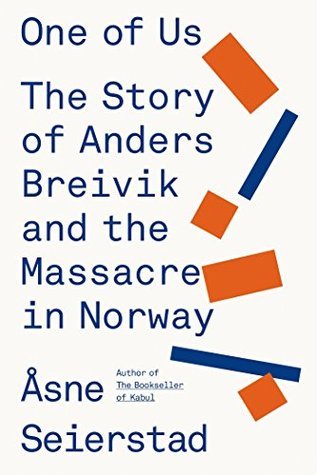
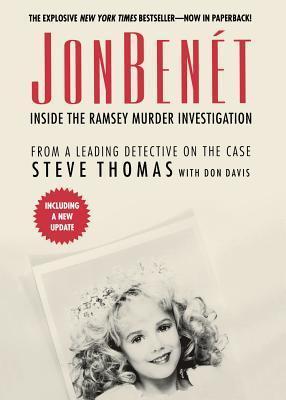






Quick Review of the True Crime Books I read in 2017 (Part 1)
Review of books in 2016 Part 1 and Part 2
Review of books in 2015
One of Us: The Story of a Massacre in Norway -- An its Aftermath by Asne Seierstad: You can tell that this well researched book has the signature of an experienced investigative journalist like Asne Seierstad. The novel offers a very clear and engaging account of the 2011 Norway massacre, in which Anders Breivik killed 77 people, most of them teenagers, as a misguided stance against multiculturalism, which he felt was ruining his country. Using Breivik’s own writings, police records and witness’ interviews, Seierstad builds a fascinating and deep profile of a perpetual loser with delusions of grandeur. At the same time offers, without judgment of her own, an interesting look into the mind of a mass murderer. Breivik might not be a school shooter, but you can certainly make some connections to them. The author alternates Breivik’s life story with that of two of his victims, which helps put a clear face to that horrendous death toll. I can only assume she chose those two because their families were willing to talk to her, but to be honest, their stories are very ordinary and she makes them look like perfect kids, so the chapters focused on them are not as compelling. But this is definitely a must read for anyone interested in true crime and especially in mass shootings.
JonBenet: Inside the Ramsey Murder Investigation by Steve Thomas: This book was frustrating, both because of what’s happening in the story and also because the obvious bias of the author makes it difficult to look at the case with any perspective but his own. Thomas was one of the main investigators in the early years of the JonBenet Ramsey case, and is very clear about his belief that her parents, John and Patsy, are responsible for her death and staged the crime scene, and he has some decent arguments to support that staging. The problem comes when he has to explain how and why the murder happened, then his theory falls short. This has always been my issue with the Ramsey case: there’s just not one theory that fully makes sense. Thomas’ opinion (he’s very fond of the “In my opinion” phrase) is that Patsy accidentally killed her during a fit of rage because she had wet the bed, but I just don’t see it. And while pushing that forward, he ignores other variables and suspects (Burke just doesn’t exist in his vision). He’s very adamant about the Ramseys avoiding police and getting special treatment (which in itself is no evidence of guilt), but he’s very vague about, for example, whether JonBenet had a history of sexual abuse. He mentions clearing “hundreds of suspects” for the intruder theory, but doesn’t say who or how. Thomas details the way that the DA’s office kept meddling in favor of the Ramseys, to the point that they are likely the main reason why this case went unsolved (along with some mediocre police work, no matter how Thomas tries to embellish it), but the problem is that his frustration with that --that eventually led him to quit not just the case, but the whole police force-- colors pretty much everything he has to say. He comes across as so angry and bitter, that when I finished I felt that I was missing a big part of the story he just didn’t seem willing to tell us. Bottomline, this is a fundamental read in the JonBenet saga but it would be a mistake to consider it an absolute truth and must be read with a healthy touch of skepticism.
Bitter Remains by Diane Fanning: I like reading books about crimes I have absolutely no prior knowledge about, and that was the case here. The novel, written by one of the big american names in the true crime genre, tells the story of Laura Ackerson, murdered by her ex, Grant Hayes, and his wife Amanda. The story is extremely tragic and gruesome, with the book focusing on the victim’s troubled life and how she was managing to overcome her problems and make a better life for herself and her two sons when she was killed at only 27. Fanning does her best to present us with all the context about the case, but she doesn’t pretend to be understanding or sympathetic with the two killers, especially Grant who seems to be one of the most despicable people you’ll ever read about. This book really lays down in all its horror how human life holds so little value to some people.
For Laci by Sharon Rocha: I thought a book couldn’t get more heartbreaking than Sue Klebold’s A Mother’s Reckoning, but I was wrong. Sharon Rocha’s grief over the loss of her daughter Laci --who disappeared while heavily pregnant on Christmas’ Eve of 2002, only to be found five months later, her body decapitated-- grips you through the pages and squeezes your heart. In Sharon’s words, Laci comes alive as a likeable, cheerful woman who made the world a better place. On the other hand, her husband Scott Peterson, currently in death row for murdering her and their unborn son, is portrayed as a callous, cold and narcissitic individual who would rather end his wife’s life than deal with a messy divorce or be tied down by a kid. As you can imagine, Sharon’s presentation of the case is the same as the police’s and prosecution’s, and it’s the version I believe. The circumstancial evidence against Peterson is too overwhelming, and tied together builds a stronger case than any DNA sample without context could ever make. Sharon describes Laci and Scott’s relationship and his growing distaste of the idea of becoming a father, and also her own struggle when she started to realize that the son in law she was publicly supporting was guilty (on a side note, Scott’s parents are particularly terrible, at least in Sharon’s eyes). Unless you somehow believe that Peterson is innocent, this is a very poignant and touching read.
Illusion of Justice by Jerome F. Buting: This book was written by one of Steven Avery’s defense lawyers, who also happens to be my favorite character in Making a Murderer. Here, he explores not only the behind the scenes of the Avery trial, but also other cases of his stellar career and why he believes the justice system is broken. And he succeeds in making you understand why there can't be real justice if the process to convict someone isn't clean. The author talks a lot about his own life, which I found quite interesting, particularly the cancer that almost killed him. He’s a man of strong convictions who’s worked hard to improve a flawed system. I was expecting more revelations about the Avery case, and he does sheds some light on what was going on that we didn’t see in the documentary (I especially love his jabs at unethical prosecutor Ken Kratz), but nothing truly shocking. He clearly believes in Avery's innocence, although he doesn’t say it outright. Instead, he focuses on explaining why his arrest and trial was a miscarriage of justice. And he has a point. There’s also a segment in the last part in which he addresses frequently asked questions and misconceptions that people have about the case (for example this confusion about “sweat DNA”). He also devotes plenty of time to talk about another big case of his, the one of Ralph Armstrong, who spent almost 30 years in jail for a horrible crime he didn't commit. If you enjoyed Making a Murderer and are interested in the judicial aspects of true crime, this book is for you. It's very informative, told in an easy, fluid narrative.
The Innocent Man by John Grisham: As a big fan of courtroom dramas, I love most of John Grisham’s stories (A Time to Kill is among my favorite novels, period). I was excited to check out this, his first non fiction story, which focuses on Ron Williamson, a mentally ill man and drug addict who, along with his friend Dennis Fritz, was sent to death row for the horrific 1988 rape and murder of Debbie Carter. DNA testing cleared them both 11 years later. All the elements are there: a fascinating case of wrongful conviction, the mystery of who the real killer was (although the book makes it pretty obvious from the start), the fight to make justice. But I have to admit I was underwhelmed by it. There was something very tedious about the way Grisham decided to write it, and I think part of it isn’t really his fault, it’s just that Ron Williamson is not an interesting character, aside from being wrongfully accused, and the big chunk of his story that makes up for the first half of the book really made me lose interest.
Similar Transactions by S. R. Reynolds: Ever heard of Larry Lee Smith? I hadn’t before I read this book. He’s a serial rapist who most likely also murdered 15 year old Michelle Anderson in 1987, although that case is still officially unsolved. This book is the effort a woman called Sasha Reynolds to shed some light to Michelle’s case and to tell the story of Smith, an unrepentant predator who went back to attacking women every time he was released from jail. Halfway through the book, Reynolds inserts herself in the story but in the third person. She explains she did it so she wouldn’t mess with the narrative, but it felt a little weird to me. She, however, doesn’t put herself at the center of the story and makes the victims the protagonists. Because of the nature of the crime, in the wrong hands this book could be too graphic or sensationalist, but Reynolds is very careful and respectful without hiding the horrors all these women went through. In times when sexual abuse is on the frontline news, this books really shows the way such stories should be covered.
Overkill by Lyn Riddle: Despite that ghastly cover, that makes this novel look like a cheap thriller, the book is a serious attempt to cover in excruciating detail the senseless murder of Laurie Show. In 1991, the 16 year old was beaten and stabbed by Lisa Michelle Lambert, who had started harassing her because Laurie briefly dated her boyfriend Lawrence Yunkin while the two were separated. Yunkin and a friend of Lambert, Tabitha Buck, also actively participated in the crime and the three of them were convicted for it. Lambert, a master manipulator that would put Jodi Arias to shame, said that the police framed her with the murder to hide the fact they had gang-raped, and managed to convince a judge to overturn her conviction. He even went as far as to forbid the state from re-trying her. That was eventually scratched, and Lambert went back to jail where she’s staying for good. It’s a long and complicated legal process, and the main problem of this book is that it goes so deep into it, it becomes incredibly boring. Even for someone like me, that likes the trial part of any case, it was almost impossible to go through. The book has good elements, like a nuanced portrayal of all the characters involved, but it’s so repetitive and exhausting that I just can’t bring myself to recommend it.
#true crime#tcoriginal#anders breivik#jonbenet ramsey#steven avery#laci peterson#john grisham#ron williamson#larry lee smith#laurie show#review#book review
54 notes
·
View notes